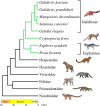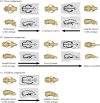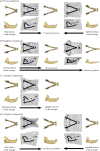Skull evolution and lineage diversification in endemic Malagasy carnivorans
- PMID: 39445090
- PMCID: PMC11496717
- DOI: 10.1098/rsos.240538
Skull evolution and lineage diversification in endemic Malagasy carnivorans
Abstract
Madagascar is one of the world's foremost biodiversity hotspots with more than 90% of its species endemic to the island. Malagasy carnivorans are one of only four extant terrestrial mammalian clades endemic to Madagascar. Although there are only eight extant species, these carnivorans exhibit remarkable phenotypic and ecological diversity that is often hypothesized to have diversified through an adaptive radiation. Here, we investigated the evolution of skull diversity in Malagasy carnivorans and tested if they exhibited characteristics of convergence and an adaptive radiation. We found that their skull disparity exceeds that of any other feliform family, as their skulls vary widely and strikingly capture a large amount of the morphological variation found across all feliforms. We also found evidence of shared adaptive zones in cranial shape between euplerid subclades and felids, herpestids and viverrids. Lastly, contrary to predictions of adaptive radiation, we found that Malagasy carnivorans do not exhibit rapid lineage diversification and only marginally faster rates of mandibular shape evolution and to a lesser extent cranial shape evolution, compared to other feliforms. These results reveal that exceptional diversification rates are not necessary to generate the striking phenotypic diversity that evolved in carnivorans after their dispersal to and isolation on Madagascar.
Keywords: Carnivora; Madagascar; adaptive radiation; craniomandibular; phenotypic evolution; phylogenetic comparative methods.
© 2024 The Authors.
Conflict of interest statement
We declare we have no competing interests.
Figures






Similar articles
-
Lineage Diversity and Size Disparity in Musteloidea: Testing Patterns of Adaptive Radiation Using Molecular and Fossil-Based Methods.Syst Biol. 2018 Jan 1;67(1):127-144. doi: 10.1093/sysbio/syx047. Syst Biol. 2018. PMID: 28472434
-
Impact of the terrestrial-aquatic transition on disparity and rates of evolution in the carnivoran skull.BMC Evol Biol. 2015 Feb 4;15(1):8. doi: 10.1186/s12862-015-0285-5. BMC Evol Biol. 2015. PMID: 25648618 Free PMC article.
-
Single origin of Malagasy Carnivora from an African ancestor.Nature. 2003 Feb 13;421(6924):734-7. doi: 10.1038/nature01303. Nature. 2003. PMID: 12610623
-
Skull morphological evolution in Malagasy endemic Nesomyinae rodents.PLoS One. 2022 Feb 4;17(2):e0263045. doi: 10.1371/journal.pone.0263045. eCollection 2022. PLoS One. 2022. PMID: 35120158 Free PMC article.
-
Origin and Diversification of Dung Beetles in Madagascar.Insects. 2011 Apr 20;2(2):112-27. doi: 10.3390/insects2020112. Insects. 2011. PMID: 26467617 Free PMC article. Review.
References
-
- Stroud JT, Losos JB. 2016. Ecological opportunity and adaptive radiation. Annu. Rev. Ecol. Evol. Syst. 47, 507–532. (10.1146/annurev-ecolsys-121415-032254) - DOI
Associated data
LinkOut - more resources
Full Text Sources

